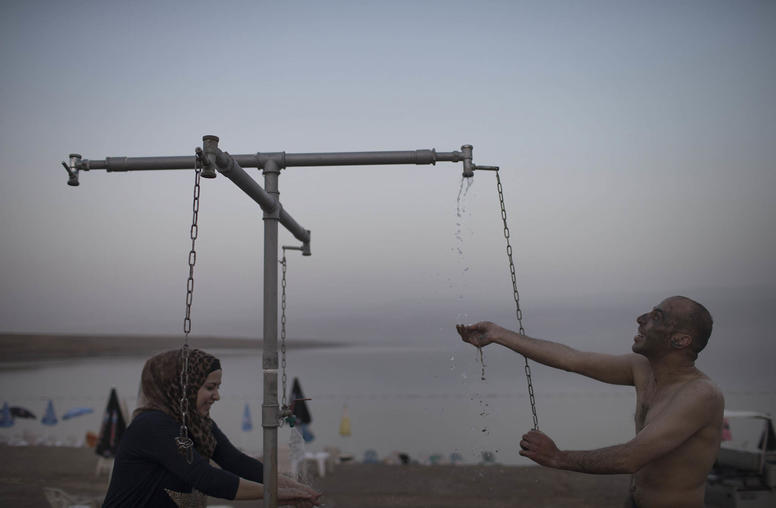Preserving Stability Amidst Regional Conflagration: US-Jordan 2011-2016
Case Study: Defense, Development and Diplomatic (“3D”) Learning from Complex Crisis
This series of case studies—Burma (2009-2015), Jordan (2011-2016), and the Lake Chad Region (2013-2016)—document efforts and draw lessons from where US government leaders believe deepening crises were staved off through collaborative inter-agency engagement. Part of USIP’s “3D Learning from Complex Crises” project, the cases provide programmatic and operational lessons from complex operating environments. These lessons support systemic integrated approaches to complex crises and will better equip individuals to share objectives when working in inter-agency environments.
Case Background
Jordan is an example of a country that has been buffeted by persistent conflict and instability in neighboring countries. It has had to contend with its own nest of challenges related to state fragility, homegrown violent extremism, and resource scarcity.
Whereas protests in Syria in 2011 precipitated civil war, protests in Jordan—of which there were more than eight thousand in 2011 to 2013—prompted Jordan’s king to repeatedly replace the prime minister, promise progress on political reforms, and seek international assistance to mitigate Jordanians’ discontent with economic and fiscal policies. Meanwhile, hundreds of thousands of Syrian refugees surged into Jordan, exacerbating water and energy shortages, overwhelming health facilities and schools, and fueling a surge in commodity prices. Conflict in Syria decreased trade and tourism in Jordan, while sabotage cut off Jordan’s gas source in Egypt. The growth of violent extremist organizations (VEOs) in Syria animated Jordan’s small Salafi Muslim population; many fought for and led VEOs in Syria, some returning more radicalized and capable of carrying out attacks. Authorities amplified border security, security force training, and intelligence to mitigate external and internal threats, and Jordan joined the fight against ISIS launched by the United States after ISIS captured territory in Iraq. Despite a handful of terrorist attacks in 2015 and 2016 and copious external and internal challenges, Jordan has remained largely stable, due in part to US support.

The US Defense, Development, and Diplomatic Response
The United States and Jordan share a long history of trying to promote peace between Israelis and Palestinians, as well as encouraging peace and security in the broader Middle East. As the Syria crisis worsened, the United States could not allow Jordan, a reliable US partner in the region, to destabilize. To help Jordan respond to new challenges required increased US assistance: the number of personnel at US Embassy Amman grew by nearly 75 percent between 2010 and 2016. The United States provided substantial economic and military support to Jordan, and all 3Ds mobilized assistance to refugees and host communities in northern Jordan. The US Department of Defense (DOD) and State Department (State) helped Jordanian forces reinforce border security and manage refugee inflows, and bulked up military training and equipment transfers to Jordanian counterparts. The 3Ds also worked closely together and with the Jordanian government to move assistance across the Syrian border, sparing many Syrians from having to flee to Jordan to meet basic needs. Capable and experienced leadership within 3D agencies, together with the innovative and adaptive structures and processes those agencies initiated, provided assistance to help Jordan bolster its stability against internal and external challenges.
Summary of Lessons from Jordan
The case study review process yielded a series of lessons in two parts:
- US assistance coordination from the field
- US assistance coordination from Washington, D.C.
Acknowledgements
This case study is the product of an extensive nine-month study that included a detailed literature review, stakeholder consultations in and outside of government, workshops, and a senior validation session. The project team is humbled by the commitment and sacrifices made by the men and women who serve the United States and its interests at home and abroad in some of the most challenging environments imaginable, furthering the national security objectives discussed herein. This project owes a significant debt of gratitude to all those who contributed to the case study process by recommending literature, participating in workshops, sharing reflections in interviews, and offering feedback on drafts of this docu-ment. The stories and lessons described in this document are dedicated to them. Thank you to the leadership of the United States Institute of Peace (USIP) and its Center for Applied Conflict Transformation for supporting this study. Special thanks also to the US Agency for International Development (USAID) Office of Transition Initiatives (USAID/OTI) for assisting with the production of various maps and graphics within this report. Any errors or omissions are the responsibility of the authors alone.
About the Authors
This case study was produced by a team led by Beth Ellen Cole, special adviser for violent extremism, conflict, and fragility at USIP, with Alexa Courtney, Erica Kaster, and Noah Sheinbaum of Frontier Design Group. Alexa and Noah previously directed the USIP-supported Fragility Study Group. Alexa has worked in USAID’s Office of Conflict Mitigation and Management, and Erica formerly served with USAID/OTI and the State Department’s Bureau of Conflict and Stabilization Operations. Noah’s work in the private sector brought additional insight into the project.




